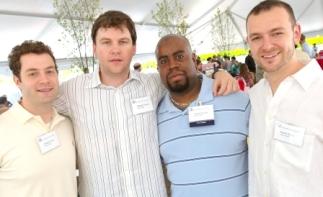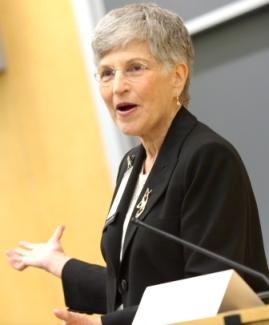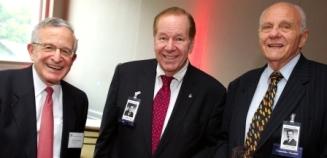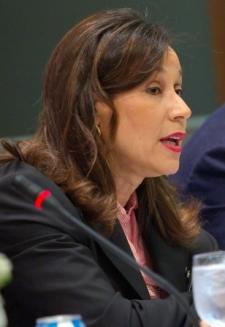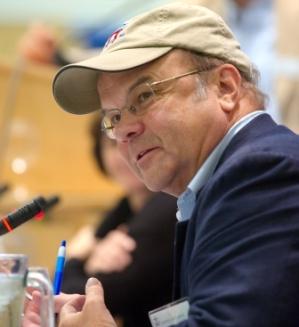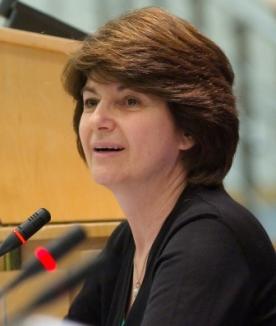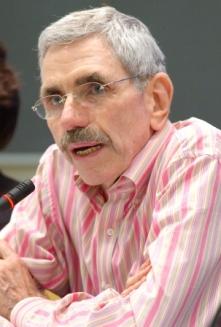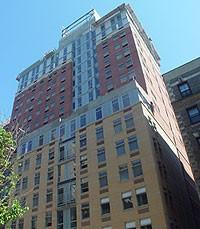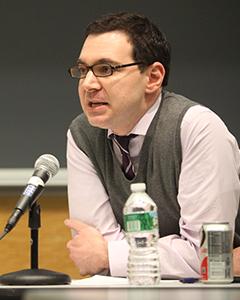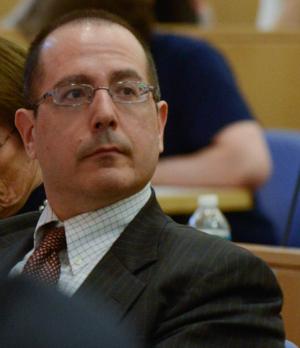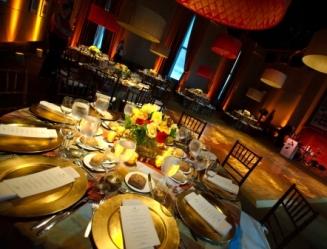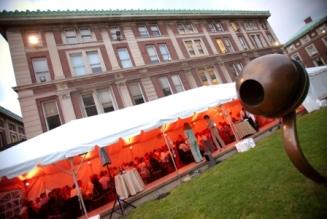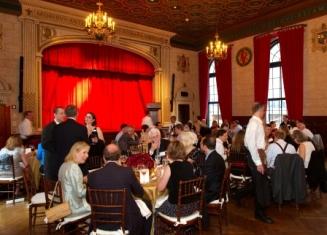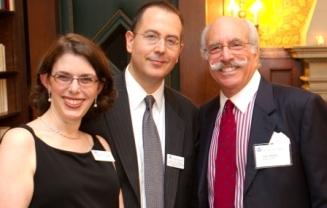More Than 1,100 Attendees At CLS Reunion Weekend 2008
More Than 1,100 Attendees At CLS Reunion Weekend 2008
MORE THAN 1,100 VISIT COLUMBIA LAW SCHOOL TO CELEBRATE DURING REUNION WEEKEND 2008
July 2, 2008 (NEW YORK) – About 1,100 people descended on the Morningside Heights campus June 6 and 7 for reunion weekend, where they touched base with old friends, took walking tours of campus, celebrated at a series of lunches, cocktail parties and dinners, and found time for some educational endeavors as well.
Graduates came from the neighborhood, from across the country and from around the world, including from London to Istanbul, to celebrate the reunions for the Classes of 1963, 1968, 1973, 1978, 1983, 1988, 1993, 1998, and 2003, as well as the 50th Reunion Class of 1958. The Stone-Agers Classes of 1953, 1948 and 1943 also joined in the festivities on Friday.
Gathering at the Saturday Reunion Luncheon were Class of
2003 alumni (left to right) Charles Cotter, Michael O'Leary,
Connie Sawyer and Daniel Davis. (Photo credit: David Wentworth)
There were alums who are regulars on campus, and others who returned for the first time since graduating 40 years ago.
Among the former was Anne Barschall ’83, a patent lawyer who works out of her home in Tarrytown, N.Y. She returns to campus every few months to use the library. “I came back because of nostalgia,” she said. “Law school was a very compact period of my life. I could practically fall out of bed and be in my classroom. There was a sense of order to that time that I haven’t experienced since.”
Then there was Stephen Conn ’68, who made his first trip back since graduating during the turbulent academic year of 1968. “In part I came back because it resonates – 1968 was a significant year,” he said. Protestors encircled the Law School building the spring semester in 1968, and classes were cancelled. Members of the graduating class received “pass-fail” grades for their spring courses.
After graduation Conn worked on a Navajo reservation in New Mexico, and later became a law professor at the University of Alaska, so he has lived in places that were not particularly convenient for making a return visit to Columbia.
Even this time, Conn, who currently lives in Point Roberts, Washington, had to head into Canada, drive back into the continental United States, take a bus for three hours, then fly to Atlanta and catch a connecting flight to New York.
Saturday's Reunion luncheon included facepainting and cotton candy for children of alumni. (Photo credit: David Wentworth)
Conn sat at lunch Saturday with classmate Charles Gholz ’68, a patent lawyer in Alexandria, Va., who said he has been back for reunion every five years. He is a former president of the Washington, D.C. area alumni association.
Orkun Guncan ’03 and Ekin Gokkilic ’98 enjoyed lunch under the tent set up Saturday in Ancel Plaza with their daughter, Irmak, 16 months old. The trio had traveled from Istanbul for the reunion. “We wanted to see our friends and to have our daughter get to see our old school,” Guncan said.
Others made surprising discoveries about people they already knew. Ashok Karmaker ’03, who works in the Empire State Building, said he sees Jerome Kretchmer ’58 routinely in the hallways there. Then the two bumped into each other at the reunion. “I never knew he was a Columbia Law School graduate!” Karmaker said.
The Hon. Anita Blumstein Brody ’58 (at left) returned to celebrate her 50th reunion. She moderated a “50th Reunion Panel of Judges” Friday in Jerome Greene Hall that featured The Hon. Arthur J. Lesemann and The Hon. Robert S. Miller. “I care about Columbia,” Judge Brody said during Saturday’s luncheon. “The school did much for me, and I want to do something in return. My education here was a very significant part of my ability to succeed.”
Brody, the first women judge in Montgomery County, PA, a suburb of Philadelphia, has been on the Law School’s Board of Visitors. Her daughter, Lisa Brody ’88, also attended the reunion.
Enjoying the Saturday night cocktail reception were 50th Reunion classmates from the Class of 1958 (left to right) Henry Weinstein, Robert Lehrman and Burton Fine. (Photo credit: David Wentworth)
Seth Weinberg ’98 and Chryssa Valletta ’98 shared a table at lunch Saturday. “I came back to see my classmates and see the changes to the school,” Valletta said. “A lot has changed over the past 10 years.”
Weinberg agreed. “I wanted to see what everyone has done with their law degree,” he said. “Law school is a pathway and I’m always interested to see where people took that.”
He was particularly intrigued by a panel discussion held Saturday morning in Jerome Greene Hall, called “Leadership Outside of Legal Practice.” The four panelists discussed how their Law School training helped them take advantage of non-traditional career opportunities when they arose.
“The discipline to do thorough research, as well as developing strong writing skills and critical thinking skills all helped me later on in other fields,” said Della Britton Baeza ’78, (at left) president and CEO of the Jackie Robinson Foundation, a college scholarship program. After law school, Baeza worked for Covington and Burling LLP. “That taught me hard work and discipline, and also a strong sense of integrity,” she said.
Later, she worked as an in-house lawyer at the American Broadcasting Corporation, which gave her exposure to a corporate environment. She and her husband next invested in several small businesses, then established a broadcast company with several TV and radio stations. After creating a record company, she joined the Jackie Robinson Foundation.
“The non-profit world is changing dramatically. It’s more challenging and also more rewarding,” Baeza said. “Now there’s an expected level of accountability similar to the corporate world. It opens the door to a lot of opportunity for people to be challenged.”
Michael Connelly ’75, (at left) CEO of Mosaica Education Inc., which manages 90 charter schools in eight states as well as Qatar and the United Arab Emirates, said Columbia Law School opened doors and socialized him to a world he had not know existed. He had grown up in St. Louis and was the first in his family to attend college.
After Columbia Law School, he worked for Casey, Lane & Mittendorf, then moved on to be executive vice president of Foster Management Company, a private business development and investment firm. That led to the presidency of Lepercq Capital Management, a private equity firm, a position he held for 12 years. Connelly joined Mosaica in 1998.
Panelist Evelyn Langlieb Greer ’73 (at left) is a commercial real estate developer in Miami, a member of the Miami-Dade County Public School Board and vice chair of Columbia Law School’s Board of Visitors. “The common thread of the people on this panel is that we are all people who kept our minds open to serendipity,” she said.
Greer, who grew up in the Bronx and graduated from Barnard, followed her husband, Bruce Greer ’73, to Miami, where she applied to one of the top law firms. She met most of their qualifications – but she wasn’t a man, and didn’t get the job. She started at another firm, but decided she didn’t merely want to give advice out to clients – she wanted to be the one acting on the advice. She entered the commercial real estate field in Miami, one of the few women in the field. “That put me in touch with government,” she said, and all the problems within her community.
She was elected in 2004 to the Miami-Dade school board, the fourth-largest system in the U.S. “Political leadership is lacking in our country, and those who have the intestinal fortitude to withstand the demeaning political process are not always the brightest lights,” she said.
“There are very few with our educational experience who get into politics, especially at the local level,” she told her fellow alumni. She ran for the school board as a way to move her community forward. “It’s not an elegant position – it’s blood and guts every day, the political process writ small.”
Panelist Jerome Kretchmer ’58, (at left) the managing partner of Gotham Bar & Grill, has been a developer and a former Democratic state assemblyman. He said he wasn’t a very good law student, but could argue cases well, and ended up running for political office, first winning a district leadership position in Manhattan in 1962 and then serving as state assemblyman representing the Chelsea-Hell’s Kitchen area from 1963 to 1970.
“The only reason I ran is because I had the nerve to do it. I had no money, no political backing,” Kretchmer said. “I explained my positions to people, and they didn’t care so much about that. I told them I was a lawyer and got my degree from Columbia Law School, and they recognized that.
“I had a terrible opinion of myself when I got here, and Columbia made me something more than I was,” he said. “The only constant through my various careers was I was educated.”
Kretchmer worked on Robert Kennedy’s 1964 U.S. Senate campaign and his 1968 presidential campaign, and went on to head the New York City Environmental Protection Agency from 1970 to 1973, serving as Mayor Lindsey’s sanitation commissioner. Kretchmer ran unsuccessfully for mayor in 1973.
He left politics, and formed the Recycling for Housing partnership in 1975. He went on to develop and sell about 1,400 housing units in New York City and Westchester.
(Left to right) Albert Cardinale and H.F. "Gerry" Lenfest from the 50th Reunion Class of 1958 caught up at the Saturday cocktail reception. (Photo credit: David Wentworth)
The events of this year’s Reunion Weekend began Friday morning with the panel of judges, followed by a 50th Reunion Luncheon for the Class of 1958 with Dean David Schizer. Everyone then decamped to the St. Regis Hotel’s Versailles Room, where Professor Benjamin Liebman moderated a panel called “Looking for Law in China.” Panelists included Phyllis Chang ’88, Xuhua Huang ’98, Jian Liu ’08, Stanley Lubman ’58 and Owen Nee ’73.
Next, Professor Matthew Waxman (above) gave a speech called “Perspective on National Security.” In the evening, guests went to the St. Regis Roof for an all-class reunion kick-off cocktail party, while the 50th Reunion Class of 1958 had their own party in The Library at the St. Regis.
On Saturday, about 100 people started the second day of reunion attending a lecture by Professor Gillian Metzger ’95 called “The Roberts Court: Where is It Going, Where Has It Been?”
As alumni settled in to the lecture hall in Greene, one was overheard saying to a classmate, “I’m going to sit in the back, like the old days.”
To which the classmate replied, laughing, “Some things never change. You afraid they’re going to call on you?”
Metzger (above) said it is still too soon to tell how the Roberts court will play out, especially since some of this term’s most contentious cases won’t be handed down until later in June.
“The court still appears to be in flux,” Metzger said. She noted there have been only five cases decided by a 5-4 vote so far this term, compared with 24 all of last term.
She also said Justice Anthony Kennedy, often viewed as a key swing vote in prior terms, seems to have somewhat diminished influence, after having been on the majority side of all 5-4 decisions last term.
She said there is more agreement between some conservative and more moderate justices. For instance, Chief Justice of the United States John G. Roberts, Jr. and Justice Stephen Breyer have concurred in 80 percent of cases so far this term, up from 63 percent in all of last term.
"So, in short, there does seem to be real change from last year afoot. On the other hand, I’d also sound a cautionary note,” she said. “The overall tenor of decisions remains conservative; what’s surprising is not that the Court has taken unexpected liberal twists, but that the decisions have not been as conservative as they might have been. We may still end up the Term with a number of 5-4s or sharply-divided, notable decisions, and the extent of crossover agreement among the Justices shouldn’t be exaggerated.
“For example, Chief Justice Roberts agrees more with Justices Alito and Scalia than Justice Breyer. Another point is that Roberts and Kennedy have a very high agreement rate: 39 out of 43 decisions. Indeed, despite his increased dissents, it’s not clear that Kennedy’s influence has diminished that much. Instead, one explanation for seeming changes in Roberts’ approach this Term is that it’s all driven by Justice Kennedy; Roberts realized that, given Kennedy, he had to move more to the center if he wanted control the majority, decide who writes the decision and affect how it is framed.”
“The court continues to have a decidedly conservative bent,” Metzger said. “But it is slightly more modulated, since decisions are more narrowly framed, leaving more room for different interpretations in the future.”
Metzger said the next president will very likely get to appoint two justices to the Supreme Court. Stevens is now 88 and there are rumors Souter wants to retire.
Metzger’s talk was followed by the panel on alternative career paths after law school. Dean Schizer (above) then gave a “State of the Law School” address, noting six new additions to the faculty for the coming year; the completion of a ninth floor of classroom, conference and office space atop Jerome Greene Hall; and the enhancements recently made to the Law School’s Loan Repayment Assistance Program, which helps reduce education debt for students who enter public interest work. Under the current program, LRAP benefits begin to phase out as a graduate earns more than $25,000. This income threshold will be doubled for the Class of 2008 and all subsequent J.D. classes. In addition, four other enhancements are being provided to all J.D. classes. Among them: loans will be forgiven more quickly, beginning after five years of eligible employment.
After the dean’s speech, alumni and their family members headed to Ancel Plaza between the Law School and the School of International Affairs. While parents got reacquainted with classmates, children enjoyed an ice cream sundae bar and cotton candy while being entertained by a balloon artist and face painter.
In the afternoon, some alumni chose to take part in walking tours of the Law Schooland the Morningside Heights neighborhood.
The reunion festivities were capped off Saturday night with individual class parties at various locations around the Columbia University campus, some in large white tents erected for the night and others in buildings including Jerome Greene Hall and Casa Italiana. The class of 2003 reunion at Havana Central Café at the West End was particularly well attended and where the youngest alums, including Caroline Bettinger-Lopéz, now a lecturer-in-law at the Law School, danced the evening away. At 9 P.M. all the classes converged for dessert and dancing to the Alex Donner Orchestra in Roone Arledge Auditorium.
Venues for the Saturday night reunion class dinners ranged from the World Room in the Journalism Building for the 50th Reunion Class
of 1958.....
...to an open-air tent on Revson Plaza for the Class of 1988.....
....to the Teatro in Casa Italiana for the Class of 1978. (Photo credits: David Wentworth)
Guy Smiley '63 (right) during the Saturday reunion dinner with Dean david Schizer and his wife, Meredith Schizer. (Photo credit: David Wentworth)
